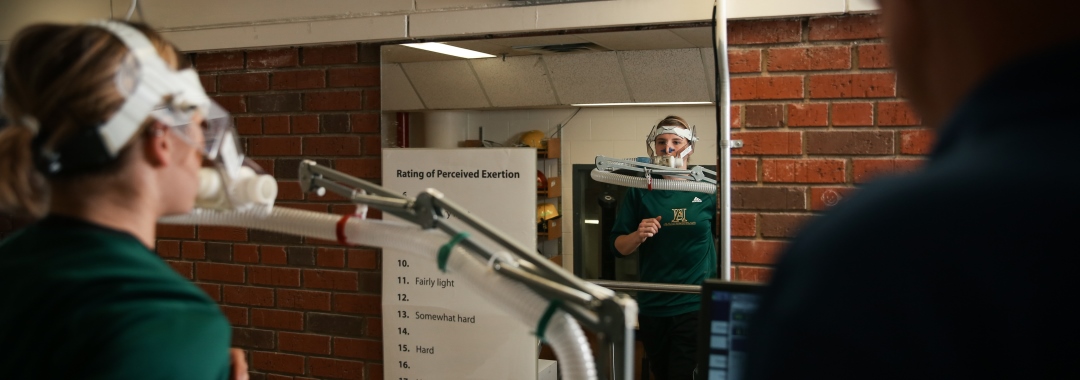Work Physiology Laboratory
What we do
The Work Physiology Laboratory investigates the physical demands of emergency response occupations such as structural firefighting, wildland firefighting, military occupations, law enforcement and search and rescue. The laboratory also conducts physical aptitude evaluations for firefighter applicants and other physically demanding trades.
Occupational Research
Starting in about 2000, we were particularly interested in the effects of the self-contained breathing apparatus (SCBA - typically worn by structural firefighters, mine rescue workers, etc) on work capacity, pulmonary ventilation and the work of breathing (see Eves et al, 2005; Dreger et al, 2006; Butcher et al, 2006; Butcher et al, 2007).
We have conducted a series of experiments using "special" gases in the SCBA that have included selected mixtures of helium and oxygen (see Eves et al, 2002a, 2002b, 2003a, 2003b and Butcher et al, 2007). In short, the results of these studies show that these special gases improve physical work capacity; decrease the effort required to breathe during strenuous work; and decrease the rate of consumption from the air tank.
We have also studied the effects of the SCBA and other fire protective equipment on heart function during exercise. (Mayne et al, 2009; Nelson et al, 2009) These studies have led to a series of experiments on heart function during passive heat stress (Nelson et al., 2010, 2010a, 2010b, 2011a, 2011b).
- Some of the research based in our lab has explored cardio pulmonary limitations to exercise.
See Stickland et al (2003, 2004a, 2004b, 2006a, 2006b) for an overview of research related to endurance exercise. - Some of the special gases that we studied with firefighters (see above) also help patients with chronic obstructive pulmonary disease (COPD) breathe during exercise.
- Research by Neil Eves and Scott Butcher during their PhD programs has led to some exciting implications for pulmonary rehabilitation programs (see Eves et al., 2006 and 2009; Butcher et al., 2009).
We have collaborated with colleagues from Human Ecology on experiments to study heat stress in different types of chemical protective clothing (see Wen et al, 2015).
Our lab recently studied the physiology of heavy load carriage. Most of our experiments have explored the effects of heavy backpacks on exercise performance and components of ventilation (see Phillips et al, 2016a, 2016b, 2016c, and Taylor et al, 2016). This has also lead to research into the effects of very heavy loads and the addition of occupational specific protective clothing on the components of ventilation and performance in wildland firefighting and law enforcement (see Phillips et al, 2016d, 2018a, 2019, and Ehnes et al, 2020).
We have completed a review and revision of our physical aptitude evaluation for structural firefighters. This has included an analysis of the effects of body mass on performance, confirmation of the validity and reliability of all of the tests and the setting of cut-scores, as well as --------- size matched sex comparisons of treadmill performance (see Phillips et al, 2018b, Scarlett et al, 2021 and 2022, and Ehnes et al, 2023).
Physical Aptitude Fitness Testing for Emergency Response Occupations
Research in our lab has focused on development of testing methodology for applicant or incumbent workers.
- We have developed a more sensitive prediction of maximal aerobic power (VO2max ) from the Leger 20-m Shuttle Run test, which is widely used in occupational fitness testing (see Stickland et al, 2003).
- We have developed and recently updated a physical aptitude test for structural firefighters (see the section on Firefighter Testing).
- We have developed, conducted and recently updated a physical aptitude evaluation for structural firefighters (see below).
- Working with researchers at the University of Victoria, we have developed a work-related physical fitness test for Canadian Forces divers (see Jones et al, 2007).
- We have developed work-related physical fitness tests for Canadian Forces Search and Rescue Technicians (SARTECH).
- We have completed research to determine a performance standard and cut-score for the Canadian Forces Physical Fitness Maintenance Evaluation (see Rogers et al, 2014 and Boyd et al, 2014).
- We have completed a review and revision of our physical aptitude evaluation for structural firefighters. This has included an analysis of the effects of body mass on performance, confirmation of the validity and reliability of all of the tests and the setting of cut-scores, as well as
size matched sex comparisons of treadmill performance (see Phillips et al, 2018b, Scarlett et al, 2021 and 2022, and Ehnes et al, 2023).
Cardio-pulmonary limitations to exercise
Some of the research based in our lab has explored cardio-pulmonary limitations to exercise.
- See Stickland et al (2003, 2004a, 2004b, 2006a, 2006b) for an overview of research related to endurance exercise.
- Some of the special gases that we studied with firefighters (see above) also help patients with chronic obstructive pulmonary disease (COPD) breathe during exercise.
- Research by Neil Eves and Scott Butcher during their PhD programs has led to some exciting implications for pulmonary rehabilitation programs (see Eves et al., 2006 and 2009; Butcher et al., 2009).
